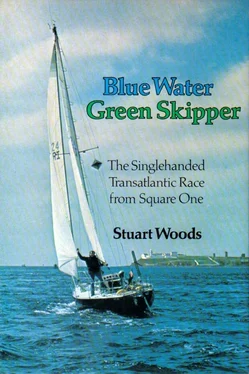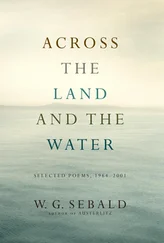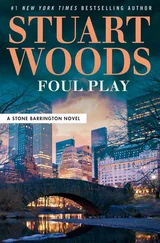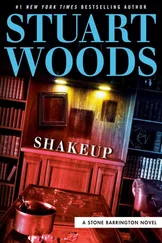The red boat was finally launched on April 11. In the water she was very pretty, and we arranged to go sailing on her with Ron and John McWilliam on Sunday.
We were joined by Harold Cudmore, a dinghy sailor, now becoming a helmsman in offshore racing, and a nonstop talker about sailing, Cork, and anything Irish. The boat was a delight to sail. I was astonished at how quickly she tacked. We sailed about Cork Harbor, while Ron ceaselessly tuned the rigging and McWilliam admired his sails. Ron never seems to stop moving on a boat. He is everywhere, dressed in a pair of white painter’s overalls, or something equally awful, completely indifferent to what the fashionable yachtsman is supposed to be wearing, and always with tools in his hands. Sometimes he will deign to wear a battered pair of seaboots. Ron seems vaguely uncomfortable in anything new, or even pressed.
McWilliam, on the other hand, is extremely neat, though not given to fashion, as such. He always seems ironed and starched, even on a boat. I think his wife presses him before he leaves the house.
Cudmore, a rangy fellow with a lot of thick, red hair and a native capacity for Guinness, enjoys giving instructions in a manner which manages to be, at once, quick and easy. Both Ron and Harold are good teachers on a boat, each having a large fund of knowledge on every detail of the sailing of a yacht, and a willingness to share it. McWilliam, on the other hand, although possessed of at least as much information, seems to assume that anyone who is over the age of seven has a native understanding of everything that makes a yacht work, and an equal knowledge of things mechanical. Once, when I interrupted him, puzzled by a discourse on load factors or something, he said to me, “You know, it’s good training for me to talk to you about things like this; your mind is so... so...” “Unsullied by knowledge?” I volunteered. He grinned. “That’s it.”
Everything about this first sail in a Shamrock was an eye-opener for me. First of all, it was, at this point in my experience, the largest boat I had ever sailed on; second, it was my introduction to what my own boat would be like, and I was both a little awed by the height of the mast and the sail area, and relieved, in that the yacht didn’t seem unmanageable. Ann, who says of her ability on a boat, “I do what I’m told,” was enjoying herself, too. At least nobody was yelling at her. She tells of a sail down the Channel once with a male companion who became Captain Bligh on a boat. She abandoned ship in Weymouth and took a train back to London.
Sailing back to moorings in front of the yacht club, Cudmore gave me a real workout. Harold would rather sail anytime than use an engine (I saw him sail up to a mooring under spinnaker once, in a riverful of moored yachts), and he decided we would short tack up the river, against the tide. Ron and McWilliam quickly found something to do on the foredeck, and I had to man both winches, with Ann tailing the sheets. I was wiped out by the time we reached the mooring, and after three months on my exercise program. It occurred to me that had I tried that in January I would have collapsed after the first four or five tacks.
Back at the Royal Cork, we ran into Hugh Coveney in the bar and got into a discussion of boats’ names. Hugh’s Golden Apple name came from Yeats... “The golden apples of the sun and the silver apples of the moon...” The “Golden” handle had continued with Golden Shamrock, and I thought I’d like to keep it going, combined with something Irish but a bit more elegant than Shamrock. The harp is the Irish national symbol, and that of the Royal Cork Yacht Club as well. Golden Harp seemed a good possibility. Hugh liked that, and I think from that time on, though I thought about other names, the yacht, in my own mind, became Golden Harp.
Ann flew back to London that afternoon, and I was alone again. Still, my boat was about to begin building, and I was about to make my first passage of the season and my first to England. Golden Apple had been sold, and Hugh Coveney had invited me to sail on the delivery trip.
10
My first golden cruise
The next two weeks were mostly occupied with final meetings about the molding of the boat. I think we had at least three final meetings. I was beginning to have doubts about some of the modifications planned for the boat. First, I abandoned the idea of replacing the whole cockpit and decided just to make the existing one deeper. Then I was talked out of that, because of doubts about the cockpit draining properly when heeled. Finally, George talked me out of raising the decks with the teak sandwich idea. He was concerned about the possibility of leaks around the hull/deck join. I gave in on the custom interior, too. I would accept the Swede’s standard interior and simply add extra stowage space.
A letter came from Mike Ellison of the Amateur Yacht Research Society, who was helping to organize the Azores race. When Harry McMahon and Ewan Southby-Tailyour had not been able to get enough free time to do the race, I had told Mike I’d consider taking a girl crew, which the committee had suggested entrants do. Now Mike had two candidates for me, and the following day I received a letter from one of them, Shirley Clifford. She sounded fine, but she was married to Richard Clifford, a Royal Marine officer who had done the last OSTAR, and I wrote her a frank letter explaining that I had not expected inquiries from a married lady, and that I didn’t want any angry Marines buzzing about. I didn’t, either.
Golden Apple departed about one o’clock on a Friday afternoon, Hugh Coveney having come down to provision and fuel us. The rest of the crew were Ian Hannay, skipper, an English airline pilot and, as it turned out, a former British Olympic helmsman in the Dragon class; Richard Edwards, an English medical student; and Killian Bush, George’s son. Killian worked at the yard and had crewed on Apple the year before. I’d had some sort of mild bug since the day before and was feeling rotten, so as soon as we set sail at Roche’s Point, at the mouth of Cork Harbor, I turned in until time for my watch. It annoyed me to feel poorly at the beginning of a trip to which I had so looked forward; it was my first sail out of sight of land.
I was awakened later by the sound of the engine starting. It was a sound I would grow to hate during the next three days. The wind had been light when we set sail, and now it had dropped to nothing. Motoring on a Ron Holland one-off racing yacht is not like motoring on anything else. Instead of the purr of an engine, muffled by soundproofing, we had a deafening chug, muffled only by a panel of sailcloth between the quarter berth and the engine. Soundproofing is too heavy to be used on a superfast Holland design. We motored on through the late afternoon and into the evening, picking up, at some point, an exhausted pigeon who perched on a spreader, hunkered his head down, and fell into an apparently dreamless sleep, stirring himself from time to time to shit on the deck below.
Dawn came slowly, and we found ourselves motoring onward in a haze that made it impossible to judge distance. The sun shone weakly through it. The effect was one of being anchored in one place with the engine running, there was so little sensation of movement in the haze. By late afternoon things had cleared enough to sight Land’s End, my first landfall in a yacht, and that was exciting. That lower-left-hand corner of England was abeam by 20.00 hours, and I turned in after my three-hour watch, looking forward to nine uninterrupted hours of sleep. Motoring was curiously tiring, and I still felt rotten. I was awakened by Hannay at 03.00 after only six hours of sleep and told that I was on watch. (Often on a yacht when racing, or when cruising in heavy weather, the skipper and/or the navigator does not take a watch, but saves himself and is awakened if there are problems.)
Читать дальше












